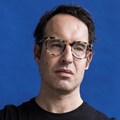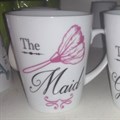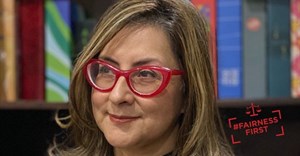#FairnessFirst: Meet the future of advertising

In fact, Cinman himself said very little in the session apart from a brief introduction to the agency, stating, “What’s important about VML is not me but the amazing talented young people that make up VML in SA; the future of the industry.” The agency is Level 1 for BB-BEE, reflected throughout their staff complement.
Articles about the ad industry today are very doom and gloom, almost apocalyptic what with client budgets going down, but if you do it right, you can build businesses with incredible culture, that are incredible places to be, as the team feels free and safe to express their creativity. Cinman calls that a competitive advantage.
Proving this to be true were lead strategist Atiyya Karodia, designer Nomonde Mtetwa, UX designer Julie Reid, account director Velile Ximba, and content director Nondu Petlele.
Guardians of pop culture
Karodia’s presentation, titled ‘guardians of pop culture’, highlighted the role of marketers and brands in society today. Her journey to advertising was clear-cut from childhood: While other kids were playing ‘shop shop’, she was playing ‘New Horizons’ with her cousins – that’s the fictional ad agency from soapie, Generations. Fast forward and here she is.
Explaining ‘Guardians of Pop Culture’, she had a bad day at the office with a difficult client, where she was losing faith in the industry and her role in it. Still feeling like an angsty, 16-year-old anarchist at heart, part of an all-girl skate crew, she published a dark post on Facebook.
Former agency CEO Jason Xenopoulos got in touch with her and said, “Brands are the best chance we have to make meaningful change.” The true meaning of this only landed with her earlier this year. Brands, marketers and entertainers are the three pieces that shape pop culture, that’s what people see all the time.
Karodia said Anthony Bourdain’s Parts Unknown showed him trying to get in to the culture in Libya just after Gaddafi was assassinated and taken to an off-brand KFC, as the guide explained, “This is what freedom tastes like.” That’s the power of branding. That’s why brands need to go beyond treating digital as a channel, there’s immense responsibility to be purposeful and authentic in this age of the conscious consumer.
Work she’s proud of that demonstrates this ethos, as it flips the script on the ‘bank advertising’ we’ve come to expect:
Karodia concludes that sure, you have to sell stuff, but there’s also a huge responsibility to move society forward.
We don’t just sell shit, we shape culture.Cinman agreed that the role of the ad agency has changed, and done right you can steer the world towards a better place.
Digital is the consumer’s new voice
Next was 22-year-old junior designer Nomonde Mtetwa, with VML for 8 months now, who said she may be small, but she has a huge passion for doing big things. Explaining how and why she got into the industry, she spoke of her love of drawing and creating from an early age. Fine art wasn’t for her, but she was always loud and expressive.
A rebel in school who was always in trouble with teachers, her love for advertising, branding and design started when she moved to Johannesburg, because:
To someone from Nelspruit, Joburg was like New York – it was big, they had trains and taxis everywhere, the streets were dirtier, the walls were higher and there was graffiti on the walls.Graffiti is Mtetwa’s thing, a way to speak to people using your talent. She saw advertising as a way to have your artistic creation displayed on a huge platform, for all to see and to make an impact on people’s lives. That was back in 2005. Since then she feels advertising has changed.
She’s part of the generation that grew up with technology and tweeting and advanced gaming consoles, so she says the internet is our playground with gifs, memes, emojis and stories the basis of the way we communicate and share content, as we now speak more openly on those platforms about issues like race, gender, gender violence, LGBTQI+, identity, politics and privilege than we ever did before.
It’s the young generations pushing these conversations and the culture of sharing and speaking our minds. They’re loud, expressive and unapologetic about it. With the rise of social media, brands can now listen to their consumers and #trend, for the right reasons.
There are ads everywhere, our phones and social media feeds are becoming as cluttered at Joburg. That’s where Mtetwa feels young people who know their way around the internet can step in at agencies. They should be the ones who help dictate the way brands speak to us, as digital is the playground of the young.
Solving the world’s problems with UX
Cinman then introduced Julie Reid, a philosophy graduate like himself who has been a user experience or UX designer at VML since last year. Her presentation started with the opener: “Hi, I’m Julie and the world is a mess. Here’s how UX can help.”
Explaining how she got into UX design and why she thinks UX is the way to solve the world’s problems, as does philosophy.
Through her work with disabled people, she got first-hand insight into what it’s like to not be what’s regarded as ‘normal’, and life is like when there is no UX. At the heart of it, it’s about making things easier for people, making their tasks intuitive and natural, saving frustration and even saving lives.
That means a day in the life of a UX designer is more than just digital interfaces, instead you need to create personas of your users and let that inform how you design. The design then evolves through the process, though Reid admits it can be like playing broken telephone at times as different departments have different priorities and jargon."What we don't realise is our responsibility to move our society forward." - @VMLSouthAfrica is coming in hot at #DigitalAgencyShowcase. pic.twitter.com/YAcR2DDKaU
— Red & Yellow School (@RedAndYellowEd) October 25, 2018
A lot of her work has involved redesigning forms, so that’s they’re not overwhelmingly scary, as well as helping people find products easier in stores. It’s about having influence over what seems normal to people.
Reid concluded that the problems of the world are vast and overwhelming, but we can only fix them if enough people prioritise and act on their intentions to work to change them. That’s ultimately how UX can change the world: With its insight into human behaviour, it subtly influences what people take to be normal, easy to do and important in the design of all that is mass produced and accessed.
The (super)power of learning from others
Next, Cinman said the department that’s often overlooked and the heroes behind the scene is the client services team. They don’t get the glory, but they do a lot of the work.
Ximba said when she went to VML for her client service internship interview while completing her honours degree, they were blasting hip hop-music, someone was wearing a tail and there were people moving around on scooters She said to herself, ‘Yes, I am home.’.She thought to herself that she’d be interviewed by MD (at the time) of the country’s leading digital agency, so if she wasn’t going to get the job, she would at least soak up some nuggets for her thesis. So Cinman didn’t realise Ximba was also interviewing him.
She got the job and her life turned green – Nedbank green, as that was her main brand for four years. Ximba shared that in client services, you effectively steer the ship and need to deal with disasters like brief changes and budget cuts. More than crisis management, it’s about building strong client relationships, and staying on top of trends as you’re effectively the face of the team for the brand, so need to know what’s going on from a strategy, creative and UX point of view.
Her job is very meme-friendly, from the follow-up email to the ‘meeting that could have been an email’, and when your client asks if you can do it cheaper.Thanks @VMLSouthAfrica for all the laughs! #DigitalAgencyShowcase #clientservice #designers pic.twitter.com/nhfsmBiOqF
— Red & Yellow School (@RedAndYellowEd) October 25, 2018
An example of work she's loved working on is Go Sandile – the 17-year-old double-amputee who was motivated to start using his new prosthetic legs, while also raising funds for others in the same boat.
Ximba concluded that the best part of her job is working in tribes and learning from the other disciplines at VML. That's her (super)power. It's a life-long learning philosophy that would serve us all well.
Creating cultural content the nation loves
Last up was the ever-so-nervous but oh-so-awesome Petlele – the girl who trolled Mango after they lost her luggage for the Loeries last year. It was not a PR stunt. They responded to her that there isn’t much damage you can do on social media (and yes, she did get back her luggage)…
Bathong! @FlyMangoSA #bringbackmyluggage pic.twitter.com/vxPgunjYPS
— a guy named joshua (@mrmaboea) August 17, 2018
Then she left Mafikeng to join Digify’s three-month digital boot camp course, followed by an internship at VML which progressed into a community management role and then content director, all for Nando’s. She admits it was stressful at first as it’s such a big brand and there are all these expectations, but it’s been a good four years now and she loves her work.
Petlele says to keep your ear to the ground, quoting Louise Marsland as follows:
So many brands, organisations and even media companies are getting it wrong with out-of-date tweets, boring tweets, arbitrary tweets that state the obvious, not the real news, too many retweets, too many tweets in a row.She showed some of her favourite Nando’s work and often gets asked how they get it right, as so many brands get slaughtered on social media for being sexist or racist. Her answer is always, “Are you even on Twitter? There are so many little communities and people speaking about things that affect them. Things that affect people of colour, the LGBTQI+ community and no one is taking the time to listen to what they’re saying.
She also spoke of the lack of diversity in creative teams – everyone looks the same and comes from the same background, which means you’re less likely to have someone raise their hand to flag something as offensive.
Petlele also says to speak to people how they speak, which makes your brand more relatable. That’s part of the Nando’s appeal. When I find myself thinking, “That’s what my mom says all the time,” that’s when I connect to a brand.
People like brands that actually understand them. That’s what she’s constantly pushing with Nando’s.
People, know Nando’s for their cheeky spiciness, but there’s more to it than just responding to tweets. They’re quite deliberate in what they post and have built such a strong community that others will respond and defend the brand before they do.
Cinman reiterated the importance of diversity by saying you don’t just hire a diverse team, you need to trust that diverse team’s ideas, too and not get in their way. Know what you know, what you don’t know, and make space for other people’s point of view.
And that’s the future of advertising.
Red & Yellow chairman Rob Stokes concluded that they will definitely hold another showcase next year. That concludes my #DigitalAgencyShowcase coverage, and follow VML South Africa on Twitter for the latest updates.

About Leigh Andrews
Leigh Andrews AKA the #MilkshakeQueen, is former Editor-in-Chief: Marketing & Media at Bizcommunity.com, with a passion for issues of inclusion, belonging, and of course, gourmet food and drinks! Now follow her travel adventures on YouTube @MidlifeMeander.Related
TFG and VML triumph at the Smarties 2025 Awards 9 May 2025 Sarah Griffiths joins Red and Yellow as new head of marketing 24 Apr 2025 3 big emerging commerce developments South African brands need to know about right now 10 Feb 2025 The Future 100: 2025 - A year of challenge and opportunity for brands 27 Jan 2025 VML tackles representation with Africa-focused AI image generator 21 Jan 2025 SA agencies shine at inaugural METAP region TikTok Ad Awards 29 Nov 2024





































